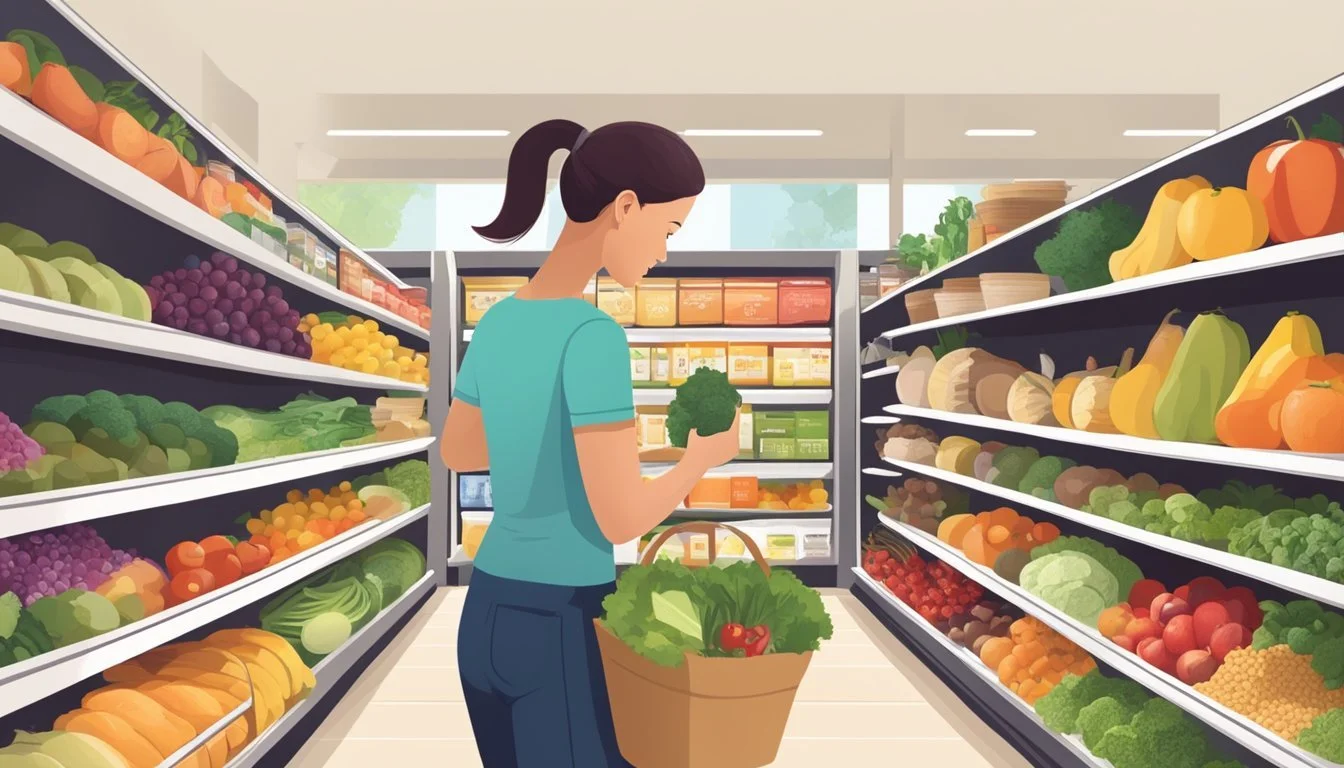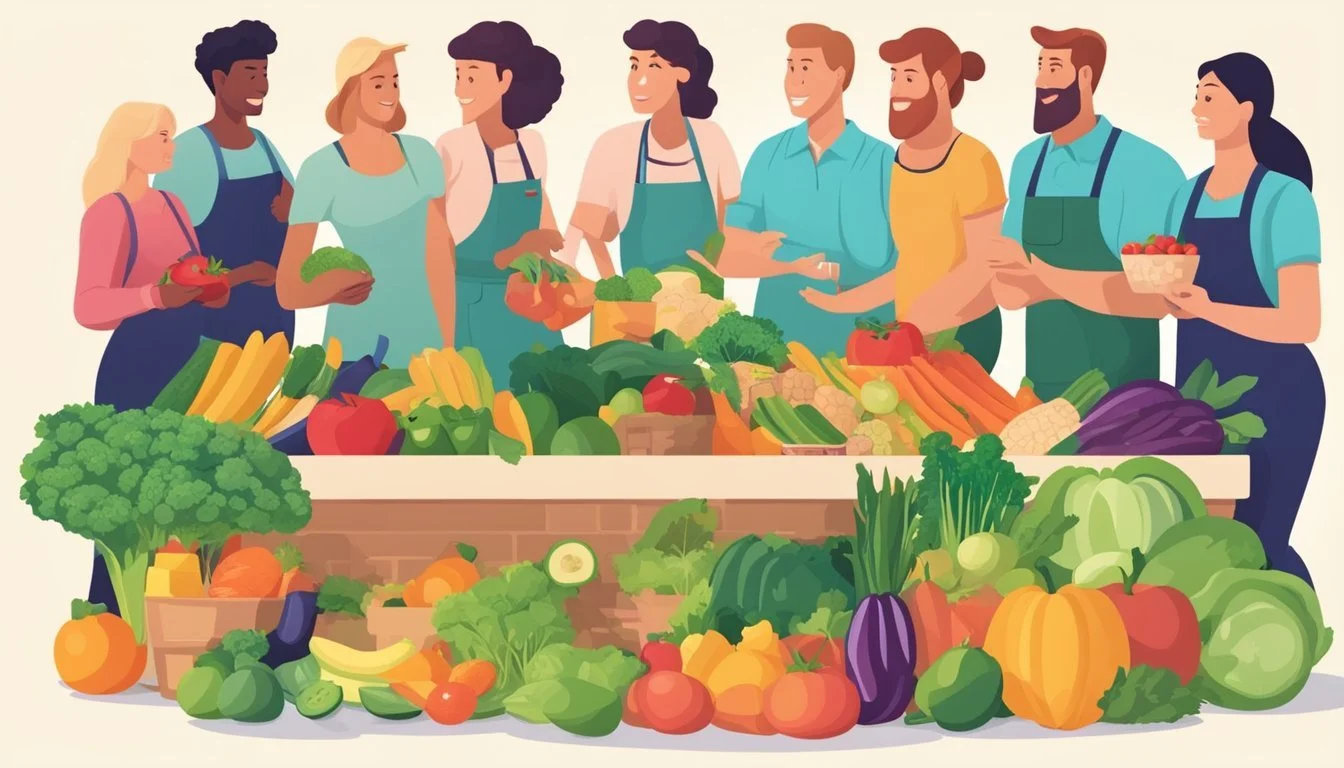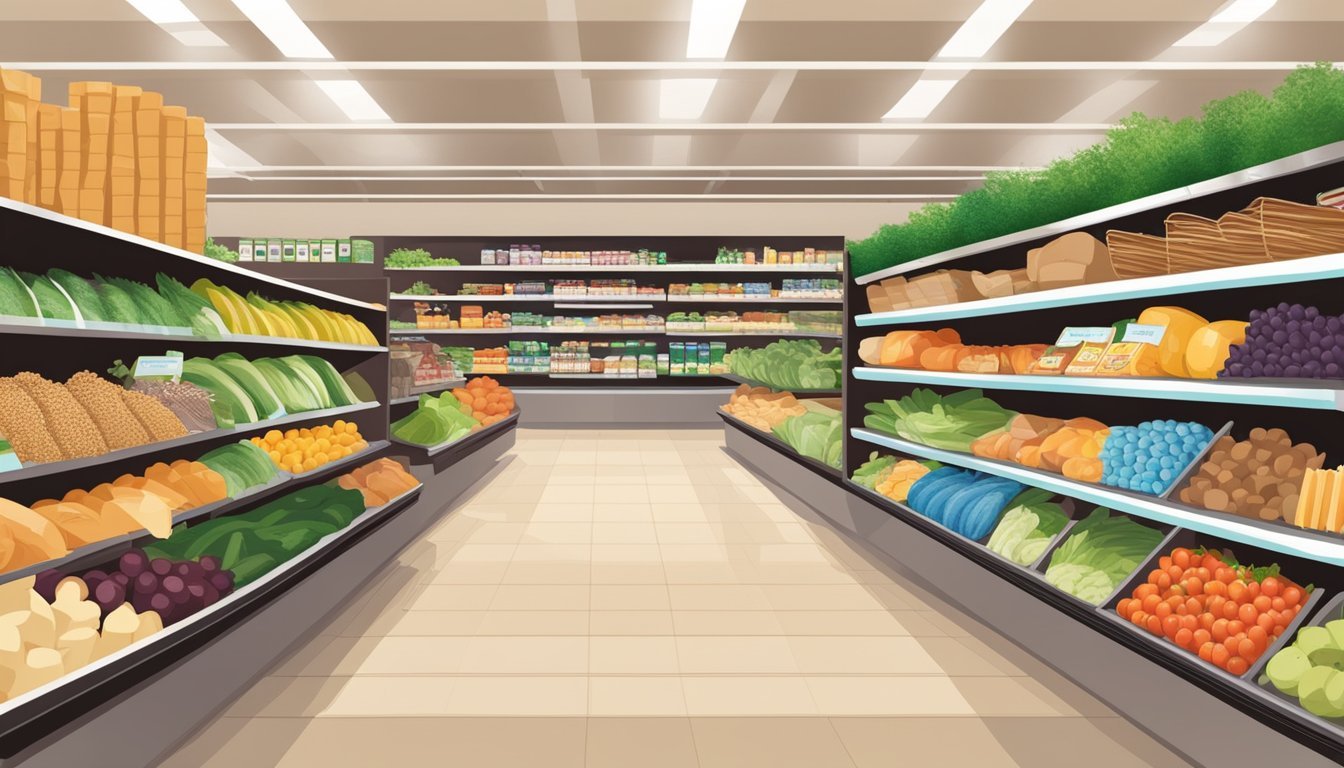Slim Aisles: Unveiling the Best Grocery Stores for Your Weight Loss Journey
When embarking on a weight loss journey, choosing the right grocery store can significantly impact success. Certain stores offer a wider variety of healthy, nutrient-dense foods that support weight management goals. The best grocery stores for weight loss typically provide an extensive selection of fresh produce, lean proteins, whole grains, and minimally processed foods.
These stores often prioritize organic and locally sourced options, making it easier to find high-quality ingredients for nutritious meals. They may also feature dedicated sections for specialty diet items, such as low-carb or plant-based products. Additionally, some stores offer in-house nutritionists or dietitians who can provide guidance on making healthier food choices.
Creating a well-planned grocery list before shopping is crucial for staying on track with weight loss objectives. Focus on filling the cart with fruits, vegetables, lean meats, fish, whole grains, and healthy fats. By selecting a grocery store that aligns with these nutritional priorities, individuals can set themselves up for success in their weight loss endeavors.
Understanding Weight Loss Fundamentals
Weight loss occurs when the body burns more calories than it takes in. This process requires a balanced approach focusing on diet and nutrition.
The Role of Diet in Weight Loss
Diet plays a crucial role in weight loss. Consuming nutrient-dense foods provides essential vitamins and minerals while keeping calorie intake in check. Fruits, vegetables, lean proteins, and whole grains are excellent choices.
Portion control is key. Smaller portions help reduce overall calorie consumption without eliminating favorite foods entirely.
Meal planning can support weight loss efforts. Preparing meals in advance ensures access to healthy options and reduces the temptation of high-calorie convenience foods.
Hydration is often overlooked but vital. Water can help increase feelings of fullness and boost metabolism.
Calories and Nutritional Balance
Calories are units of energy. To lose weight, one must create a calorie deficit by burning more calories than consumed.
A balanced diet includes:
Proteins (15-25% of daily calories)
Carbohydrates (45-65% of daily calories)
Fats (20-35% of daily calories)
Tracking food intake can help maintain this balance. Many apps and tools are available to simplify the process.
Not all calories are equal. 200 calories from broccoli provide more nutrients than 200 calories from candy. Focus on nutrient-dense foods to maximize nutritional value while managing calorie intake.
Selecting Foods for a Weight Loss-Friendly Pantry
A well-stocked pantry supports sustainable weight loss by providing nutritious options for meals and snacks. Focus on nutrient-dense whole foods, fiber-rich grains, and lean proteins to create a foundation for healthy eating.
Staples for Nutrient Density
Fill your pantry with nutrient-dense staples to maximize nutritional value. Canned vegetables like tomatoes, corn, and green beans offer convenience and essential vitamins. Choose low-sodium varieties when possible. Stock up on beans and lentils for plant-based protein and fiber.
Herbs and spices add flavor without calories. Keep a variety on hand like basil, oregano, cumin, and cinnamon. Broths and stocks serve as low-calorie bases for soups and sauces.
Include nuts and seeds for healthy fats and protein. Almonds, walnuts, and chia seeds make great snacks or additions to meals.
Whole Grains and Fiber Rich Foods
Whole grains provide sustained energy and promote feelings of fullness. Stock brown rice, quinoa, and oats as versatile bases for meals. Whole grain pasta offers more fiber than refined varieties.
High-fiber cereals make quick breakfasts or snacks. Look for options with at least 5 grams of fiber per serving. Keep whole grain crackers on hand for a crunchy snack or light lunch option.
Popcorn kernels offer a low-calorie, high-fiber snack when air-popped. Avoid pre-packaged varieties with added fats and salt.
Healthy Fats and Proteins
Include sources of healthy fats in your pantry. Extra virgin olive oil serves as a versatile cooking oil and salad dressing base. Avocado oil offers a higher smoke point for high-heat cooking.
Canned fish like tuna and salmon provide lean protein and omega-3 fatty acids. Choose varieties packed in water rather than oil. Nut butters offer protein and healthy fats - opt for natural versions without added sugars.
Protein powders can supplement meals or create quick smoothies. Choose unflavored varieties to avoid added sugars. Keep eggs in your refrigerator as a versatile protein source for any meal of the day.
Strategizing Your Grocery Store Visits
Planning your grocery store trips can significantly impact your weight loss journey. A well-thought-out approach helps you make healthier choices and avoid impulse purchases.
Navigating the Aisles for Healthier Picks
Start your shopping trip in the produce section. Fill your cart with a variety of colorful fruits and vegetables. These fiber-rich foods promote satiety and provide essential nutrients.
Move to the protein aisle next. Choose lean meats, fish, and plant-based proteins. These options are lower in saturated fat and support muscle maintenance during weight loss.
Limit time spent in center aisles. These often contain processed foods high in added sugars, sodium, and unhealthy fats. When necessary, opt for whole grain products and low-sodium canned goods.
Dairy products can be tricky. Select low-fat or fat-free options to reduce saturated fat intake. Greek yogurt and cottage cheese are protein-rich choices that can aid weight loss efforts.
Decoding Product Labels and Nutrition Information
Learn to read nutrition labels effectively. Focus on serving sizes, calories, and macronutrient content. Compare similar products to find those with less added sugar, sodium, and saturated fat.
Check ingredient lists. Choose items with shorter lists and recognizable ingredients. Avoid products with sugar or its aliases (like high fructose corn syrup) listed among the first few ingredients.
Look for health claims with caution. "Low-fat" doesn't always mean healthy, as these products may contain added sugars. "Natural" isn't a regulated term and doesn't guarantee nutritional value.
Use the % Daily Value as a quick guide. Aim for lower percentages in sodium, saturated fat, and added sugars. Higher percentages are desirable for fiber, vitamins, and minerals.
Essentials of a Weight Loss Grocery Cart
A well-planned grocery cart supports successful weight loss efforts. Focusing on nutrient-dense, whole foods provides the foundation for a balanced and satisfying diet.
Produce Section Favorites
Fresh fruits and vegetables form the cornerstone of a weight loss grocery cart. Leafy greens like spinach and kale offer vitamins and fiber with minimal calories. Colorful bell peppers, carrots, and tomatoes provide antioxidants and flavor.
Berries make excellent low-calorie snacks and add natural sweetness to meals. Apples and pears offer portable options for on-the-go eating. Citrus fruits like oranges and grapefruits can boost metabolism.
Cruciferous vegetables such as broccoli and cauliflower are filling and nutrient-rich. Zucchini and squash serve as low-carb alternatives for pasta dishes.
Choosing Lean Meats and Alternatives
Lean proteins help maintain muscle mass during weight loss. Skinless chicken breast and turkey are versatile, low-fat options. Fish like salmon and tuna provide healthy omega-3 fatty acids.
Lean cuts of beef, such as sirloin or flank steak, can be enjoyed in moderation. Pork tenderloin offers a leaner alternative to fattier cuts.
Plant-based proteins like tofu, tempeh, and legumes are excellent choices for vegetarians or those looking to reduce meat consumption. Eggs provide high-quality protein and essential nutrients.
Dairy and Dairy Alternatives
Low-fat or fat-free Greek yogurt offers protein and probiotics. Cottage cheese serves as a versatile, protein-rich option for meals or snacks.
Skim milk or unsweetened plant-based milk alternatives like almond or soy milk can be used in smoothies or with whole-grain cereals. Low-fat cheese can be enjoyed in moderation to add flavor to dishes.
Nutritional yeast provides a cheesy flavor with added B-vitamins for those avoiding dairy. Unsweetened dairy-free yogurts made from coconut or almonds offer probiotic benefits.
Frozen Foods as Convenient Nutrient Sources
Frozen fruits and vegetables retain nutrients and provide convenience. Mixed berry blends work well in smoothies, while frozen spinach can be easily added to soups or stir-fries.
Frozen fish fillets offer a quick protein source for weeknight meals. Look for options without added breading or sauces.
Pre-portioned frozen meals can be helpful for portion control, but choose options low in sodium and high in vegetables. Frozen cauliflower rice serves as a low-carb alternative to grains.
Meal Planning for Effective Weight Loss
Strategic meal planning is crucial for successful weight loss. By preparing balanced, nutritious meals in advance, you can stay on track with your goals and avoid impulsive food choices.
Weight Loss Breakfast Ideas
Start your day with protein-rich options to keep you feeling full. Egg white scrambles with vegetables provide lean protein and fiber. Greek yogurt parfaits layered with berries and a sprinkle of low-fat granola offer probiotics and antioxidants.
For a quick option, blend a green smoothie with spinach, banana, and plant-based protein powder. Overnight oats prepared with almond milk and chia seeds deliver slow-release energy and omega-3 fatty acids.
Whole grain toast topped with avocado and a poached egg creates a satisfying combination of healthy fats and protein. These breakfast choices kickstart metabolism and provide sustained energy throughout the morning.
Light and Nutritious Lunch Options
Salads are versatile lunch choices for weight loss. Build a nutrient-dense base with mixed greens, spinach, or kale. Add lean proteins like grilled chicken, tuna, or tofu. Incorporate a variety of colorful vegetables such as bell peppers, cucumbers, and cherry tomatoes.
For dressing, opt for vinaigrettes or lemon juice to avoid excess calories. Sprinkle seeds or nuts for healthy fats and crunch. Alternatively, try whole grain wraps filled with hummus, vegetables, and turkey breast for a portable option.
Vegetable-based soups paired with a small whole grain roll provide warmth and satiety. Lentil or black bean soups offer plant-based protein and fiber to keep you full until dinner.
Dinner Ideas to Stay on Track
Focus on lean proteins and non-starchy vegetables for dinner. Grilled fish like salmon or cod paired with roasted Brussels sprouts and sweet potato provides omega-3s and complex carbohydrates.
Stir-fries made with chicken or shrimp, mixed vegetables, and cauliflower rice offer a low-carb alternative to traditional rice dishes. Use minimal oil and flavor with herbs and spices instead of high-calorie sauces.
Vegetarian options like quinoa-stuffed bell peppers or lentil curry with cauliflower provide plant-based protein and fiber. These dinner ideas are filling yet light, supporting weight loss goals without sacrificing taste or satisfaction.
Healthy Snacks to Support Weight Loss
Choosing nutritious snacks can play a crucial role in weight loss efforts. Incorporating protein-rich options helps promote satiety between meals.
Eggs make an excellent snack choice. Hard-boiled eggs contain just 50 calories while providing 5.5 grams of protein. Their high protein content contributes to feelings of fullness.
Nuts offer another satisfying snack option. Almonds, walnuts, cashews, and pistachios deliver healthy fats, fiber, and protein. Aim for a 1-ounce portion to keep calories in check.
Fresh fruits provide natural sweetness with vital nutrients. Pair apple slices with a tablespoon of nut butter for a balanced snack. Berries offer antioxidants and fiber with minimal calories.
Greek yogurt serves as a versatile snack base. Mix in cinnamon or vanilla for flavor without added sugars. Its high protein content supports muscle maintenance during weight loss.
For a savory option, try turkey pepperoni. It provides a leaner alternative to traditional pepperoni while still offering protein and flavor.
Cheese lovers can opt for baked cheese crisps. These crunchy snacks deliver protein and calcium in a convenient form. Pair with a small handful of cashews for added nutrients.
Vegetables like red bell peppers make excellent snack choices. Dip them in guacamole for healthy fats and extra flavor.
Weight Loss Superfoods to Include
Incorporating nutrient-dense foods into your diet can significantly support weight loss efforts. These superfoods provide essential vitamins, minerals, and compounds that boost metabolism and promote satiety.
Vegetables High in Fiber and Antioxidants
Spinach stands out as a versatile leafy green packed with fiber and antioxidants. It contains only 7 calories per cup while offering iron, vitamin C, and folate. Broccoli is another excellent choice, providing 31 calories and 2.4 grams of fiber per cup. This cruciferous vegetable is rich in vitamin C and contains compounds that may help reduce inflammation.
Kale deserves special mention for its nutrient density. One cup of raw kale provides 33 calories and 2.9 grams of fiber. It's an exceptional source of vitamins A, C, and K.
Proteins That Promote Satiety
Chicken breast is a lean protein source that supports muscle maintenance during weight loss. A 3-ounce serving provides about 26 grams of protein with only 140 calories. It's versatile and can be prepared in numerous healthy ways.
Eggs are a nutritional powerhouse, offering 6 grams of high-quality protein per large egg. They contain only 78 calories each and provide essential nutrients like vitamin D and choline. Studies have shown that eating eggs for breakfast can increase feelings of fullness and reduce calorie intake throughout the day.
Fruits That Offer a Natural Sweetness
Berries are low in calories but high in fiber and antioxidants. A cup of strawberries contains just 49 calories and provides 3 grams of fiber. Blueberries, with 84 calories per cup, are rich in anthocyanins which may aid in fat metabolism.
Apples and pears are excellent choices for weight loss. A medium apple contains about 95 calories and 4.4 grams of fiber. Pears offer similar benefits with 101 calories and 5.5 grams of fiber per medium fruit. The high fiber content in these fruits promotes feelings of fullness and aids digestion.
Expert Advice from Nutrition Professionals
Consulting nutrition experts can provide valuable guidance for making informed choices at the grocery store to support weight loss goals. These professionals offer personalized recommendations based on individual needs and health conditions.
Meeting with a Registered Dietitian
A registered dietitian can create a tailored grocery list to meet specific nutritional needs. They assess an individual's current diet, health status, and weight loss goals. Dietitians provide education on reading nutrition labels and selecting nutrient-dense foods.
These experts emphasize the importance of balanced meals containing lean proteins, complex carbohydrates, and healthy fats. They may recommend foods rich in essential micronutrients, including vitamins and minerals, to support overall health during weight loss.
Dietitians can suggest suitable portion sizes and meal planning strategies. They often provide practical tips for navigating grocery store aisles and making healthier choices. This personalized approach helps individuals develop sustainable shopping habits that align with their weight loss objectives.
Integrating Superfoods and Supplements
Superfoods and supplements can enhance your weight loss efforts when incorporated strategically into your diet. Certain nutrient-dense foods and targeted supplements may boost metabolism, reduce cravings, and support overall health during weight management.
Incorporating Seeds and Omega-3s
Chia seeds are a powerful addition to any weight loss plan. These tiny seeds expand in the stomach, promoting fullness and reducing appetite. They're rich in fiber, protein, and omega-3 fatty acids.
Sprinkle chia seeds on yogurt, blend them into smoothies, or use them as an egg substitute in baking. Aim for 1-2 tablespoons daily.
Other omega-3 rich foods include flaxseeds, walnuts, and fatty fish like salmon. These foods can help reduce inflammation and support heart health while aiding weight loss efforts.
Consider keeping pre-portioned seed mixes in your pantry for easy snacking or meal additions. This ensures you get a variety of beneficial nutrients without overconsuming calories.
Understanding the Benefits of Superfood Supplements
Superfood supplements can fill nutritional gaps in your diet. Green powders often contain nutrient-dense ingredients like spirulina, chlorella, and wheatgrass.
These supplements are rich in antioxidants, which combat oxidative stress and may support metabolism. Look for products with minimal added sugars or fillers.
Calcium and vitamin D supplements can be beneficial, especially if dairy intake is limited. These nutrients support bone health and may play a role in weight management.
Be cautious with superfood supplements. They shouldn't replace whole foods but can complement a balanced diet. Always consult a healthcare provider before starting any new supplement regimen.
Hydration and Weight Loss
Proper hydration plays a crucial role in weight loss efforts. Drinking adequate water supports metabolism, reduces appetite, and helps the body function optimally.
Benefits of Staying Hydrated
Drinking water boosts metabolism, potentially increasing calorie burn. It acts as a natural appetite suppressant, helping reduce overall calorie intake. Water aids in the breakdown of fat cells and supports proper digestion. Staying hydrated improves exercise performance and recovery, enabling more effective workouts. Proper hydration also helps reduce water retention, which can mask weight loss progress.
Lemon water offers additional benefits. The citrus fruit adds flavor while providing vitamin C and antioxidants. Some studies suggest lemon may enhance fat burning, though more research is needed to confirm this effect.
Alternatives to Sugary Drinks
Replacing high-calorie beverages with water or low-calorie options supports weight loss goals. Unsweetened tea, both hot and iced, provides hydration with minimal calories. Coffee, when consumed black or with a splash of low-fat milk, can boost metabolism. Sparkling water with a squeeze of citrus fruit offers a refreshing, calorie-free alternative to soda.
Infused waters add variety without excess calories. Cucumber, mint, and berries make flavorful additions. Herbal teas, served hot or cold, provide hydration and potential health benefits. Low-fat milk and plant-based alternatives offer hydration along with protein and other nutrients.
Smart Seasoning Choices
Spices and herbs can transform the flavor of meals without adding excess calories. They offer a way to enhance taste while supporting weight loss goals.
Herbs and Spices for Flavor Without the Calories
Cinnamon stands out as a versatile spice that can add sweetness to dishes without sugar. It pairs well with oatmeal, yogurt, and baked goods. Sprinkle it on apple slices for a satisfying snack.
Turmeric brings a warm, earthy flavor to meals. Its active compound, curcumin, has anti-inflammatory properties. Add it to soups, curries, or scrambled eggs for a nutrition boost.
Cayenne pepper can increase metabolism and reduce appetite. Use it sparingly in sauces, marinades, or sprinkled on roasted vegetables. Start with small amounts to gauge heat tolerance.
Garlic powder offers concentrated flavor without the need for oil or butter. It enhances the taste of lean proteins, vegetables, and whole grains. A little goes a long way in dressings and rubs.
Herbs like basil, oregano, and thyme add freshness to dishes. They work well in salads, pasta, and grilled meats. Fresh or dried, these herbs provide flavor complexity without extra calories.
Lifestyle and Behavioral Tips for Grocery Shopping
Strategic grocery shopping habits can significantly impact weight loss efforts. Careful planning and mindful decision-making while shopping help create a healthier home food environment.
Avoiding Impulse Purchases
Plan meals and create a detailed shopping list before heading to the store. This focused approach helps resist tempting but unhealthy impulse buys. Shop after eating a nutritious meal to reduce hunger-driven choices.
Stick to the store's perimeter, where fresh produce, lean proteins, and dairy products are typically located. Limit trips down center aisles containing processed foods.
Use a smaller cart or basket to naturally limit purchase quantities. Set a budget for treats and stick to it, allowing occasional indulgences without derailing weight loss goals.
Timing Your Shopping for Optimal Choices
Shop early in the day when willpower is strongest and crowds are smaller. This reduces stress and allows for more thoughtful decision-making.
Visit the store mid-week when produce is often restocked. Fresher fruits and vegetables are more appealing and nutritious, encouraging increased consumption.
Avoid shopping during peak hours or when tired, as these conditions may lead to hasty, less healthy choices. Schedule regular shopping trips to maintain a steady supply of fresh, wholesome foods at home.
Consider online grocery ordering for staples to minimize in-store temptations. This can help maintain focus on nutritious choices and reduce exposure to less healthy options.










